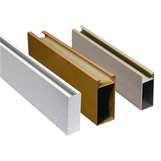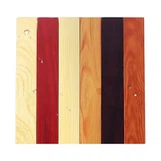Drilling holes in an aluminum solid plate is a common task in various industries, from construction to manufacturing. As a reputable supplier of Aluminum Solid Plates, I understand the importance of providing not only high - quality products but also valuable knowledge to our customers. In this blog post, I'll guide you through the process of drilling holes in an aluminum solid plate, ensuring you achieve precise and clean results.


Understanding Aluminum Solid Plates
Before we delve into the drilling process, it's essential to understand the nature of aluminum solid plates. Aluminum is a lightweight, corrosion - resistant metal with excellent thermal and electrical conductivity. Our aluminum solid plates are made from high - grade aluminum alloys, which offer superior strength and durability. These plates come in various thicknesses and sizes, suitable for a wide range of applications, such as 3D Aluminum Composite Panel, Aluminum Composite Roof Panel, and Cladding Aluminum Composite Panel.
Tools and Materials Required
To drill holes in an aluminum solid plate, you'll need the following tools and materials:
- Drill Press or Hand Drill: A drill press provides more accuracy and stability, especially for larger or multiple holes. However, a hand drill can be used for smaller projects or when mobility is required.
- Drill Bits: High - speed steel (HSS) drill bits are suitable for most aluminum drilling applications. For harder aluminum alloys, cobalt or carbide - tipped drill bits may be necessary. The size of the drill bit will depend on the diameter of the hole you want to create.
- Clamps: These are used to secure the aluminum plate to the workbench, preventing it from moving during the drilling process.
- Cutting Fluid: Using a cutting fluid, such as a water - soluble coolant or a light machine oil, can reduce friction, prevent overheating, and improve the quality of the drilled hole.
- Safety Equipment: Safety glasses, gloves, and ear protection should be worn to protect yourself from flying debris and noise.
Pre - drilling Preparation
- Mark the Drilling Points: Use a center punch and a hammer to mark the exact locations where you want to drill the holes. The center punch creates a small indentation that helps the drill bit stay in place and prevents it from wandering.
- Secure the Aluminum Plate: Place the aluminum plate on a flat and stable workbench. Use clamps to secure it firmly, ensuring that it won't move during drilling.
- Select the Right Drill Bit: Choose a drill bit with the appropriate diameter for the hole you want to create. Make sure the drill bit is sharp and in good condition.
- Prepare the Cutting Fluid: If using a water - soluble coolant, mix it according to the manufacturer's instructions. If using a light machine oil, have it ready for application.
Drilling Process
- Set the Drill Speed: Aluminum is a soft metal, so a relatively high drill speed is usually required. However, the exact speed will depend on the diameter of the drill bit and the thickness of the aluminum plate. As a general rule, use a higher speed for smaller drill bits and a lower speed for larger ones.
- Apply Cutting Fluid: Before starting to drill, apply a small amount of cutting fluid to the drilling point. This will help lubricate the drill bit and reduce friction.
- Start Drilling: Hold the drill perpendicular to the surface of the aluminum plate. Apply gentle and steady pressure as you start the drill. Let the drill bit do the work, and avoid forcing it too hard, as this can cause the drill bit to break or the hole to become uneven.
- Drill Slowly and Steadily: As you drill, maintain a slow and steady feed rate. This will ensure that the drill bit cuts through the aluminum smoothly and evenly. If the drill bit starts to bind or overheat, stop drilling, apply more cutting fluid, and check the alignment of the drill bit.
- Clear the Chips: Periodically stop drilling to clear the chips from the hole. This will prevent the chips from clogging the drill bit and affecting the drilling process. You can use a brush or compressed air to remove the chips.
- Drill Through the Plate: Continue drilling until the drill bit breaks through the other side of the aluminum plate. Once the hole is complete, turn off the drill and remove the drill bit from the hole.
Post - drilling Finishing
- Deburr the Holes: Use a deburring tool or a file to remove any sharp edges or burrs from the drilled holes. This will improve the safety and functionality of the holes.
- Clean the Plate: Wipe the aluminum plate clean with a cloth to remove any cutting fluid, chips, or debris.
- Inspect the Holes: Check the drilled holes for accuracy and quality. Make sure the holes are the correct size and shape, and that the edges are smooth.
Troubleshooting
- Drill Bit Breakage: If the drill bit breaks during drilling, it may be due to a dull drill bit, excessive pressure, or incorrect drill speed. Replace the drill bit, adjust the pressure and speed, and start drilling again.
- Uneven Holes: Uneven holes can be caused by a wandering drill bit or an unstable workpiece. Make sure the drill bit is properly centered and the workpiece is securely clamped.
- Overheating: Overheating can occur if the drill speed is too high or the cutting fluid is not applied properly. Reduce the drill speed, apply more cutting fluid, and allow the drill bit to cool down before continuing.
Conclusion
Drilling holes in an aluminum solid plate is a straightforward process if you follow the right steps and use the appropriate tools and materials. As a supplier of Aluminum Solid Plates, we are committed to providing you with the best products and support. Whether you're working on a small DIY project or a large - scale industrial application, our high - quality aluminum solid plates are sure to meet your needs.
If you're interested in purchasing our Aluminum Solid Plates or have any questions about the drilling process, please feel free to contact us for a procurement discussion. We look forward to working with you to achieve your project goals.
References
- Machinery's Handbook, 31st Edition
- Aluminum Association Technical Papers
- Drilling Tool Manufacturers' Technical Guides




